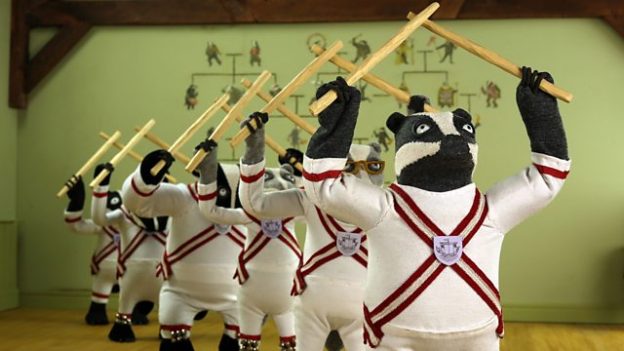By Chloe Middleton-Metcalfe, University of Roehampton
The BBC’s featured online animation for December 2018, Quarantine, is described as: ‘A post-Brexit pagan dance fantasy about a troupe of Morris-dancing badgers’ (BBC online). Quarantine builds upon a culturally pervasive idea that has been widely discredited by researchers – that folk dance has its origins in pre-Christian ritual. However documentary research has failed to provided an easily digestible alternative, tentatively suggesting some connection with the end of the Muslim-Christian wars in the Iberian Peninsula in the 15th century (Forrest 1999). With a raft of publications dating back to 1912 espousing the ritual theory, it is easy for interested individuals to be led down the pre-Christian garden path. Indeed, the ancient origins explanation probably does provide a more palatable alternative for many liberally inclined folk dance supporters than much of the historical documentation. For example, the practice of applying black face paint for ‘border’ morris was linked to anonymity and ritual, but research points to stronger links with stage minstrelsy (Metcalfe 2013). But where did the idea of ancient ritual come from in the first place?
In 1871 anthropologist Edward Burnett Tylor (1832-1917) published Primitive Culture, in which he laid out his theory of cultural survivals. Tylor posited that folklore or superstitions were ‘survivals’ of an earlier culture which had evolved leaving traces of itself behind in customs which could be seen as being cultural fossils (Hodgen 1931, Tremlett et.al. 2017). Tylor’s ideas were influenced by cultural evolutionism and drew parallels between the folklore of western civilised Europe and the culture of contemporary so-called ‘primitive’ societies, which were both inaccurate and racist (Kuper 1991, Bennett 1994). Tylor’s work was very influential as his ideas shaped James Frazer’s (1851-1941) publication The Golden Bough: A Study in Comparative Religion (1890). Frazer pieced together diverse accounts of cultural practices from around the world to argue for a universal primeval religion, of which contemporary folklore practices were the surviving fragments (Hutton 2001: 112-131). The Doctrine of Survivals became the standard explanation for most folklore, including dance (Cawte 1993).
Frazer’s theories were picked up and promoted by Cecil Sharp (1859-1924), founder of the English Folk Dance Society. As dance historian Buckland has noted (1982), between the first and second editions of the The Morris Book Sharp changed his theoretical positioning on the origins of the dance form from one which postulated the arrival of the dance in England during the reign of Edward III (1312-1377), to a theory which considered morris dancing to be ‘one of the seasonal pagan observances prevalent amongst primitive communities’ (1912: 11). Sharp had gone Frazarian. Even country dancing was linked back to ancient ritual practice with maypoles providing an imaginative link between the older form of the dance and its modern manifestations (Sharp and Oppé 1924: 6, Judge 1979 [2000]: 85).
Theories on the origins of dance more generally were also influenced by the Doctrine of Survivals. In 1895 Lilly Grove published Dancing an early history on the subject in which even the most secular forms of dance are characterised as having their roots in ‘a form of worship, or at least a form of magic’ (Grove 1895:7). Grove was perhaps unduly influenced by the Golden Bough as she later married James Frazer, but even without the family connection, many early twentieth century theories of dance were linked to the Doctrine of Survivals and an associated evolutionary-based approach to the study of culture (Buckland 2014). Influential dance historian Curt Sachs, whose ideas like Tylor’s and Frazer’s were to receive heavy criticism (Youngermann 1974), postulated that: ‘The dances of man are never mere pastimes, or artistic performances without significance; they are magic actions and in consequence constructed in such a manner as to achieve a magic purpose.’ (Sachs 1931: 30). Theories and definitions of dance emphasised the non-verbal and so dance was particularly vulnerable to discussion of animalistic instinct and primitive ritual. Indeed, popular dance histories often supplied a problematic evolutionary-based framework for the reader, who would pass through chapters of tribal and western folk dance to reach the acme of developed western theatrical dance culture – ballet (Grau 1993/4).
Whilst the contemporary dance world has successfully distanced itself from such ritualistic narratives by emphasising the role of the individual creative genius, the same cannot be said for English folk dancers. The Doctrine of Survivals and The Golden Bough continue to circulate under a number of guises (Buckland 2001/2). The 1973 cult film The Wicker Man, which drew upon The Golden Bough for inspiration did much to indirectly bring Frazer’s work to new audiences (Koven 2007, Trubshaw 2002, Scovell 2017). Arguably the most fruitful investigation of the link between morris and ritual dance would be in its current usages and understandings. Indeed, the link between folklore and non-Christian faith is a reality for some contemporary Pagans, for whom appreciation of, or engagement in, folk music and dance is a part of their religiosity (Chase 2006, Letcher 2014).

